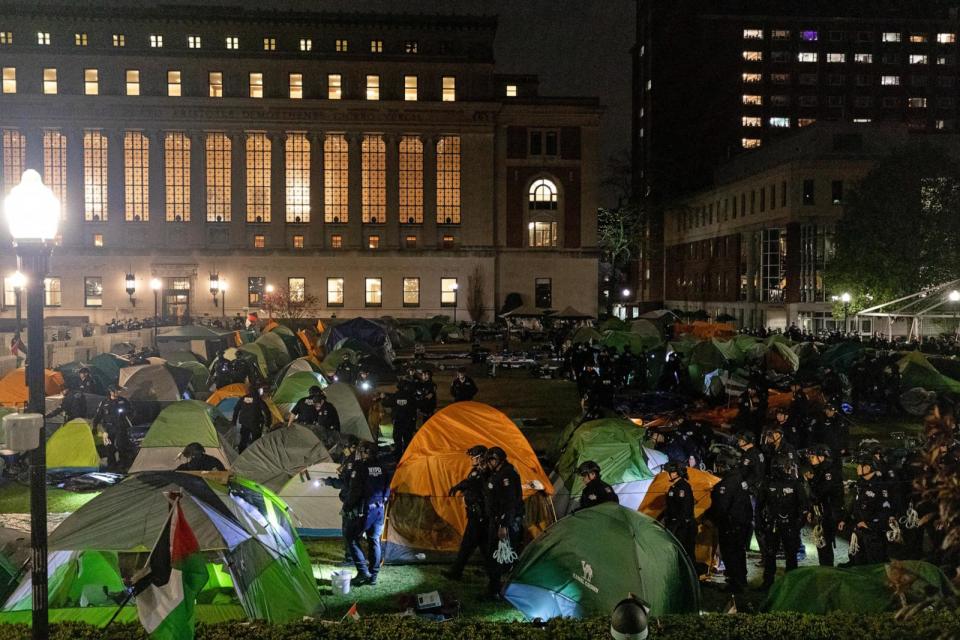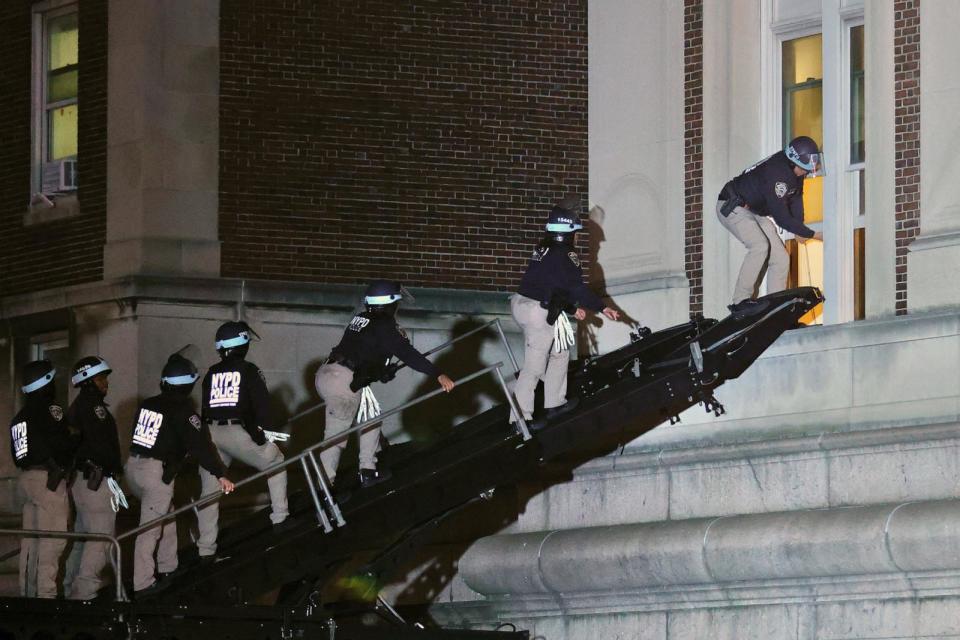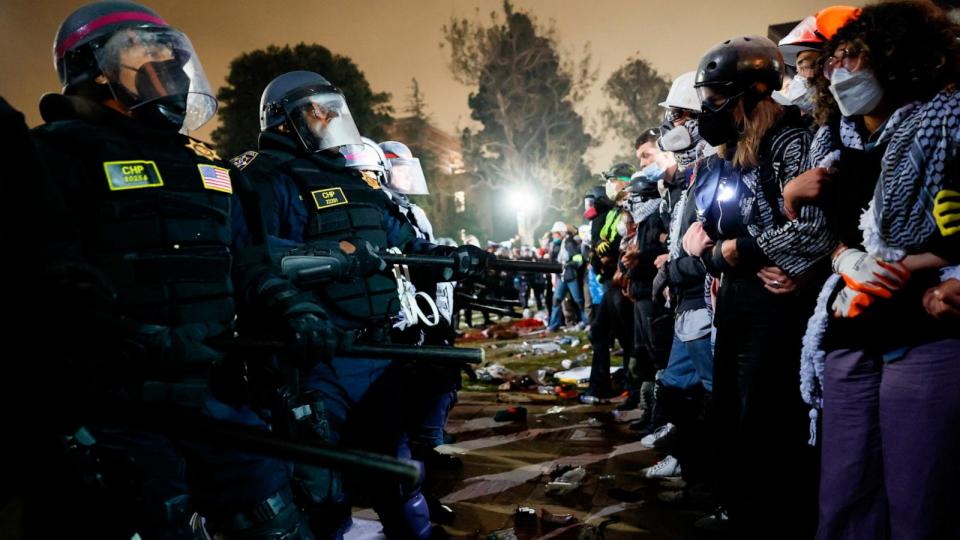Police carry out complex choreography in responding to campus protests: 'You need decisive action'
As protests continue erupting at U.S. college campuses over the war in Gaza, law enforcement from coast to coast is being tasked with carrying out a complex choreography: How to protect the constitutional right to free speech, while navigating volatile and potentially unsafe social unrest.
Dynamic scenes of massive encampments, vocal demonstrations and building occupation have now been playing out on private and public college properties – where police assistance has to be requested, not forcibly and unilaterally imposed. As they respond, authorities must carefully weigh what response might unduly escalate already tenuous circumstances – and what's critically needed to prevent dangerous discord, experts say.
Protests broke out last month at colleges and universities across the country in connection with the war in Gaza, with many pro-Palestinian protesters calling for their colleges to divest of funds from Israeli military operations or companies benefitting from the war. Over 2,000 protesters have been arrested -- many for minor offenses like trespassing -- at the campuses of Columbia University, Yale University, Harvard University, University of Texas at Austin, University of California, Los Angeles, and others, according to the Associated Press.
"It's a complex social situation that requires conversation, coordination, accommodating free speech while accommodating the needs of the greater public good and wellbeing," said Chris Burbank, former Salt Lake City police chief and adviser for the Center on Policing Equity. "Use of force is the last possible thing that we should resort to. We have to look at every other option before we get to that point and not rush in to close it down, use force, arrest people."

But when that last resort is all that remains, police must have the resources to do it, "and do it properly," Burbank added.
"You can't go willy nilly, you want to act as a unit, you need decisive action – not a preemptive strike," said Robert Boyce, an ABC News contributor and retired chief of detectives in the New York Police Department.
That can mean officers in a militarized style response, and sporting riot gear – which itself can translate to intimidating optics.
On the campus of the University of Texas at Austin, police and protesters clashed Monday afternoon after authorities issued a dispersal order.
Protesters could be heard chanting, "There is no riot here, why are you in riot gear?" Soon after, police moved in to clear the area.
In New York, as police worked to clear protesters who had occupied Columbia's Hamilton Hall, an officer accidentally discharged his gun, as he transitioned it to his non-dominant hand to unlock an office door, Assistant Chief Carlos Valdez, the commanding officer of the NYPD Emergency Service Unit, said Friday. There were no injuries and the bullet was contained within the vacant office, Valdez said, adding the shot "was purely unintentional."
Valdez defended the decision to use a SWAT team at Columbia University – citing the necessity of being prepared for unpredictable situations when dealing with barricaded individuals. ESU's standard operating procedures include the use of firearms equipped with illuminating flashlights to enhance decision-making in low-light conditions, Valdez saying “these protocols are in place to ensure that our officers are prepared for any scenario that might arise during an operation."
Burbank noted officers must take caution not to make the situation worse with the response meant to mitigate it – that police presence should be to protect, not exacerbate.
"In some cases, yes - you do have people taking over buildings and things like that, it can be very problematic, but one of the questions that I always have and will always pose, is, what did you do before it got to that point?" Burbank said.
The primary objective is to prevent conditions from escalating into destructive or violent activity, experts say. But sometimes authorities can't fully control these events and they will escalate.
MORE: What to know about 'outside agitators' cops say are co-opting Columbia protests
"Law enforcement will try to ensure that those situations are handled in a surgical way, that they don't spread," said John Cohen, the former intelligence chief at the Department of Homeland Security, now an ABC News contributor.
The delicate balance must be weighed even as local authorities juggle jurisdictions – a "key component, and a complicating factor" to already precarious conditions, Cohen said.
"Even in an urban college campus, they have to call you in - you don't patrol in there - so you still have that arm's length distance. It's a place of free thought," Boyce said. "Obviously if there's an active shooter, or a terrorist act, or a bomb - if there's an emergency we'll go in. Otherwise they have to ask us to come in asking to take these people off their premises."
Some of the escalating tensions on campus came to a boiling point this week. In New York, a group of protesters broke into Columbia University's Hamilton Hall early Tuesday and barricaded themselves in the building. New York City police officers moved in on Tuesday night, after the university said they were left with "no choice" but to allow the NYPD's help "to restore safety and order to our community." Over 100 protesters were arrested by Wednesday, over 30 of whom were not students, according to preliminary estimates. There were no reported injuries.
On Tuesday, Columbia officials asked the NYPD to come on campus and clear Hamilton Hall of the demonstrators, Mayor Eric Adams said Wednesday. Adams added that university officials acknowledged that "outside agitators were on their grounds training and really co-opting this movement."

In Los Angeles, an all-out brawl broke out among clashing protesters at UCLA early Wednesday which led to 15 injuries and one hospitalization. A police response was delayed because the university and its own police department didn't immediately authorize a request to local and state police for assistance, but instead tried to deal with the protest internally, sources told ABC News. The Los Angeles police and California Highway Patrol were called to respond to the protests hours after the violence began.
The subsequent police response at UCLA culminated in over 200 arrests, the Los Angeles Sheriff's Department confirmed Thursday.
MORE: 'Violent protest is not protected,' Biden says of college campus unrest
UCLA Chancellor Gene D. Block on Thursday defended the university's response to the violence, but said they would review their security protocols.
"When physical violence broke out that night, leadership immediately directed our UCPD police chief to call for the support of outside law enforcement, medical teams and the fire department to help us quell the violence. We are carefully examining our security processes that night and I am grateful to President Drake for also calling for an investigation," Block said in a statement.

At least two other schools including the University of Minnesota and Rutgers University reached agreements with demonstrators, ending the protests peacefully and avoiding a police response.
"College and university administrations have had a tough challenge in front of them: they have students who want to express themselves, as part of the educational experience they want people feeling safe raising their voices on issues they feel strongly. On the other hand, they also have to maintain a safe environment for students who don't share the views of those demonstrating and they can't allow the operations of the campus to be shut down," Cohen said.
Mulling these sometimes-competing values can't take too long though – at the risk of hampering an effective police response.
"In dealing with these types of demonstrations, time is not your friend," Cohen said. "The longer you wait to establish lines of communication with law enforcement, the longer a university waits to develop a contingency plan that governs when you would take action to stop the demonstration, the longer you wait to pull in the resources that can handle a rapidly evolving emergency situation, the higher the likelihood a situation is not going to be handled well."
ABC News' Alex Stone, Jason Volack and Aaron Katersky contributed to this report.
Police carry out complex choreography in responding to campus protests: 'You need decisive action' originally appeared on abcnews.go.com

 Yahoo News
Yahoo News 
